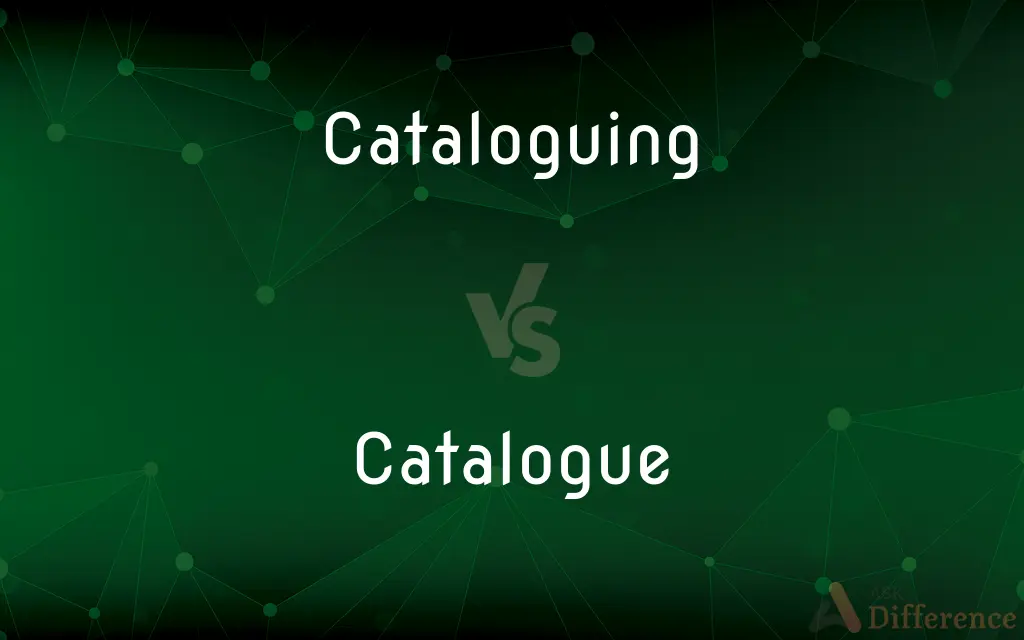Cataloguing vs. Catalogue — What's the Difference?
By Fiza Rafique & Maham Liaqat — Updated on April 2, 2024
Cataloguing is the process of listing items systematically, often for a collection or library, while a catalogue is the list or database itself.

Difference Between Cataloguing and Catalogue
Table of Contents
ADVERTISEMENT
Key Differences
Cataloguing refers to the methodical process of organizing and listing items, such as books, artworks, or products, in a systematic way to ensure easy retrieval and identification. This process involves detailed description, classification, and indexing of items. On the other hand, a catalogue is the product of this process, a comprehensive list or database that contains detailed information about each item, including descriptions, categories, and location codes.
The act of cataloguing is dynamic, involving ongoing updates and maintenance to ensure the catalogue remains accurate and reflective of the current collection or inventory. It's a verb that signifies action – the work of creating, updating, and managing the catalogue. Whereas the catalogue itself is a noun, a static entity that serves as a reference point for those seeking information within the listed items.
Cataloguing often involves a set of standards and practices, such as the Dewey Decimal System for libraries, to ensure consistency and interoperability across different catalogues and systems. These standards help in organizing information in a universally understandable way. A catalogue, however, may vary in format, ranging from printed booklets to online databases, tailored to the specific needs of its users but always adhering to these standard practices for its creation.
In a library context, cataloguing is a crucial behind-the-scenes activity performed by librarians and information professionals. It ensures that patrons can find books and resources efficiently. The catalogue, accessible to patrons either online or in physical form, is a direct interface that allows users to search for and locate items within the library’s collection based on various criteria, such as author, title, or subject.
Technology plays a significant role in both cataloguing and catalogues. Modern cataloguing often uses software and databases to automate many aspects of the process, enhancing accuracy and efficiency. Similarly, digital catalogues provide dynamic access to collections, allowing users to perform complex searches and access digital or digitized content directly.
ADVERTISEMENT
Comparison Chart
Definition
The process of systematically listing items.
The list or database resulting from the cataloguing process.
Nature
Verb; an action involving organization and description.
Noun; a static reference of items.
Context
Involves description, classification, and indexing.
Contains detailed item information for retrieval.
Format and Standards
Follows specific standards and practices.
Can vary in format but typically adheres to cataloguing standards.
Accessibility
A behind-the-scenes activity by professionals.
Directly accessible by users for searching and reference.
Compare with Definitions
Cataloguing
Listing the features and codes of software components.
Cataloguing the software modules is crucial for the development team's reference.
Catalogue
An exhibition’s list of displayed works.
The exhibition catalogue includes essays and images of the artwork.
Cataloguing
Creating a database of company assets.
Cataloguing all the office equipment ensures efficient asset management.
Catalogue
A brochure or booklet listing course offerings at a university.
The course catalogue outlines all undergraduate and graduate courses available.
Cataloguing
Organizing library books by subject and author.
Cataloguing the new donations took the librarian the entire morning.
Catalogue
A library’s collection of books and media.
The online catalogue allows you to search the library’s entire collection from home.
Cataloguing
Systematically recording art pieces in a museum.
The curator spent weeks cataloguing the new exhibit's pieces for the museum's database.
Catalogue
A retailer’s list of products for sale.
The spring catalogue features the latest gardening tools and seeds.
Cataloguing
Adding products to an online store’s inventory.
Cataloguing the latest fashion line involves detailed descriptions and photography.
Catalogue
A database of a collection or inventory.
The equipment catalogue is updated every quarter to reflect new purchases and disposals.
Cataloguing
A list or itemized display, as of titles, course offerings, or articles for exhibition or sale, usually including descriptive information or illustrations.
Catalogue
A list or itemized display, as of titles, course offerings, or articles for exhibition or sale, usually including descriptive information or illustrations.
Cataloguing
A publication, such as a book or pamphlet, containing such a list or display
A catalog of fall fashions.
A seed catalog.
Catalogue
A publication, such as a book or pamphlet, containing such a list or display
A catalog of fall fashions.
A seed catalog.
Cataloguing
A list or enumeration
A catalog of complaints.
Catalogue
A list or enumeration
A catalog of complaints.
Cataloguing
A card catalog.
Catalogue
A card catalog.
Cataloguing
To make an itemized list of
Catalog a record collection.
Catalogue
To make an itemized list of
Catalog a record collection.
Cataloguing
To list or include in a catalog.
Catalogue
To list or include in a catalog.
Cataloguing
To classify (a book or publication, for example) according to a categorical system.
Catalogue
To classify (a book or publication, for example) according to a categorical system.
Cataloguing
To make a catalog.
Catalogue
To make a catalog.
Cataloguing
To be listed in a catalog
An item that catalogs for 200 dollars.
Catalogue
To be listed in a catalog
An item that catalogs for 200 dollars.
Cataloguing
Present participle of catalogue
Catalogue
A systematic list of books, names, pictures, etc.
Cataloguing
(British spelling) The act of arranging in, or as if in, a catalogue.
Catalogue
A complete (usually alphabetical) list of items.
Catalogue
A list of all the publications in a library.
Catalogue
A retailer's magazine detailing the products they sell, allowing the reader to order them for delivery.
Catalogue
(US) A book printed periodically by a college, university, or other institution that gives a definitive description of the institution, its history, courses and degrees offered, etc.
Catalogue
A directory listing.
Catalogue
(music) A complete list of a recording artist's or a composer's songs.
Catalogue
A series of unwelcome or unpleasant things, often similar.
Catalogue
To put into a catalogue.
Catalogue
To make a catalogue of.
Catalogue
To add items (e.g. books) to an existing catalogue.
Catalogue
(philately) to value or sort stamps using a catalogue
Catalogue
A list or enumeration of names, or articles arranged methodically, often in alphabetical order; as, a catalogue of the students of a college, or of books, or of the stars.
Catalogue
To make a list or catalogue; to insert in a catalogue.
Catalogue
A complete list of things; usually arranged systematically;
It does not pretend to be a catalogue of his achievements
Catalogue
A book or pamphlet containing an enumeration of things;
He found it in the Sears catalog
Catalogue
Make a catalog of
Catalogue
Make a catalogue, compile a catalogue of something
Common Curiosities
What information is included in a catalogue?
A catalogue typically includes detailed descriptions, classifications, and location or availability information for each item.
How does cataloguing benefit a library?
Cataloguing allows for the efficient organization, retrieval, and management of library resources, benefiting both librarians and patrons.
Can catalogues be digital?
Yes, catalogues can be both printed and digital, with many organizations offering online catalogues for easier access.
What are the standards for cataloguing?
There are various standards for cataloguing, including the Dewey Decimal System and Library of Congress Classification, aimed at ensuring consistency and interoperability.
Is cataloguing only for libraries?
No, cataloguing can be applied to any collection of items needing organization, such as museum artifacts, retail products, or digital resources.
How often are catalogues updated?
Catalogues are updated regularly to reflect new additions, changes, or removals of items in the collection.
What is a catalogue?
A catalogue is a comprehensive list or database of items, organized systematically, usually for a specific collection or inventory.
What is cataloguing?
Cataloguing is the systematic process of listing and organizing items for easy identification and retrieval.
Are there different types of catalogues?
Yes, there are different types of catalogues, including public access catalogues (PACs) in libraries, product catalogues in retail, and digital catalogues online.
Can anyone create a catalogue?
While anyone can technically create a catalogue, effective cataloguing often requires knowledge of specific standards and practices.
What is the difference between a catalogue and a list?
A catalogue is a systematic and detailed list, often including descriptions and classifications, whereas a list may not follow any specific organization or include detailed information.
How do catalogues enhance user experience?
Catalogues provide a structured and easy way for users to browse, search, and access detailed information about items, improving overall user satisfaction and engagement.
How do I find a specific item in a catalogue?
You can search a catalogue using various criteria such as the item's title, author, subject, or specific keywords related to the item.
Why is cataloguing important in e-commerce?
Cataloguing in e-commerce is crucial for organizing products, enhancing the customer shopping experience through easy search and retrieval of product information.
What role does technology play in cataloguing?
Technology, especially database management systems, plays a crucial role in modern cataloguing, enhancing efficiency and accessibility.
Share Your Discovery

Previous Comparison
Dyeing vs. Dying
Next Comparison
Joke vs. JestAuthor Spotlight
Written by
Fiza RafiqueFiza Rafique is a skilled content writer at AskDifference.com, where she meticulously refines and enhances written pieces. Drawing from her vast editorial expertise, Fiza ensures clarity, accuracy, and precision in every article. Passionate about language, she continually seeks to elevate the quality of content for readers worldwide.
Co-written by
Maham Liaqat














































